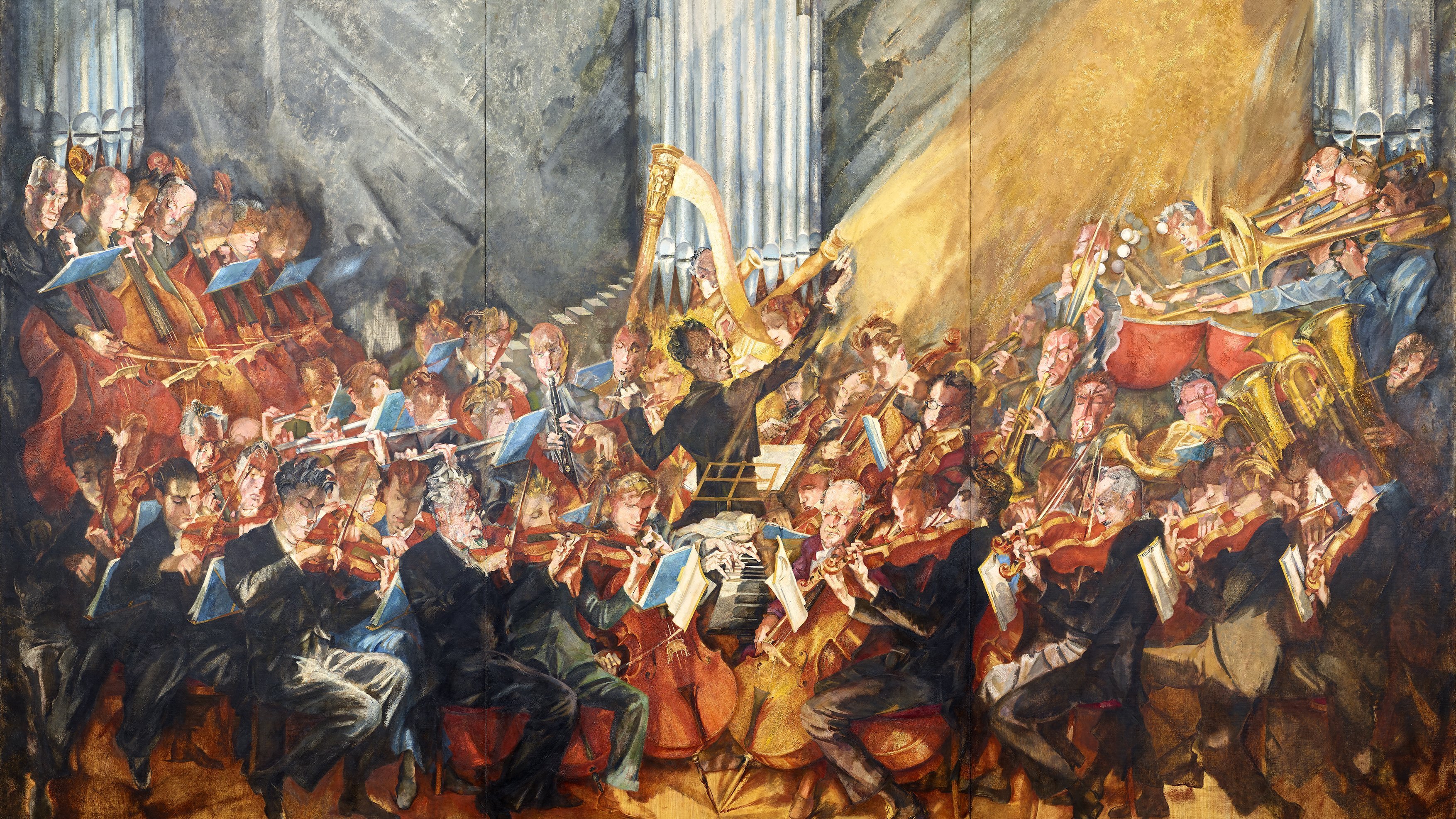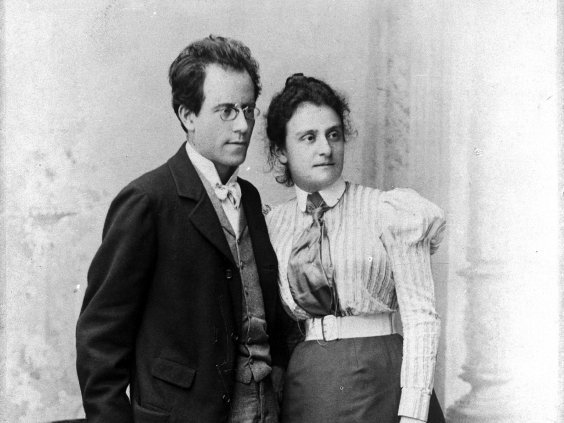- History

Mahler explored new worlds of sound in his symphonies: formally speaking, they became more complex, while also growing longer and dynamically more expressive. The composer’s vast orchestral apparatus, with its hypertrophically expanded brass and percussion sections, shocked audiences and gave caricaturists a field day. And yet Mahler was merely taking to its logical extreme a development that had already begun with Beethoven.
“Even while the audience was entering the concert hall, the platform presented an unusual sight. Quite apart from the Philharmonic Orchestra, which had been augmented in size and now numbered 120 musicians, a vast army of singers was encamped in front of them […]. In the orchestra it was possible to make out a number of mysterious instruments; half-open cases, a whole series of large bells suspended from the scaffolding on the balcony and numerous kettledrums, side drums, bass drums and so on. It was clear from all this equipment that a great battle was about to be fought. The military commander stood in the midst of his forces, ready to do battle, his brow furrowed in anticipation – at the very next moment all hell broke loose.” Thus the Neue Zeitschrift für Musik reported on the first complete performance of Mahler’s Second Symphony in Berlin – the review appeared in early January 1896, although the performance itself had taken place on 13 December 1895, when Mahler himself had conducted the Berlin Philharmonic.
It was a seminal moment in the history of music. In his reminiscences of Mahler, Bruno Walter – at this date Mahler’s young assistant at the Hamburg Opera – highlighted the evening’s significance: Mahler, he explained, had “staked his whole future as a composer on a single card after having made the most extreme and difficult sacrifices. […] The impression of a great and original work and of the power of Mahler’s personality was so great that his emergence as a composer may be said to date from this performance.”
Mahler staked everything on a single card with the first performance of his Second Symphony
Mahler was thirty-five years old at this time and had spent six years working on this symphony. His ability to solve the problems that he had addressed does indeed seem to have laid the foundations for his subsequent development as a symphonist. Over the course of his life, his Second Symphony became his most frequently performed piece, and although his critics continued to maintain a note of reserve, there was nothing that they could do to mar his success. Mahler himself declared that his music was based on personal experience, with the result that – unsurprisingly – it would scarcely be understood by those “who feel no breath of the rushing gale of our great epoch”.
The acclaimed conductor had consciously imbibed the spirit of the years of affluence following the foundation of the German Reich in 1871, and it is in those places where his music seems most subjective that it most accurately reflects the spirit of an age caught between historicism and the dawn of modernism. This was an age when the bourgeoisie had gained influence and affluence and now sought ways of displaying those qualities on the grandest scale. At the same time its members sought a sense of philosophical self-reassurance. In an increasingly secular age Mahler’s vision helped to introduce an extra-denominational and meta-religious dimension to the central question of human existence.
The intellectual and emotional range of the symphony as a genre had grown immeasurably in the space of a century. Even Mozart’s and Haydn’s most significant contributions to the medium were regarded in their day less as unique achievements than as largely interchangeable examples of their genre, combining, as they did, elements of dance, singing and playfulness in a wittily entertaining way.
No one living and working in the years around 1790 could have foreseen that with Beethoven’s Third – his “Sinfonia eroica” – the symphony would become a vehicle for ambitious intellectual ideas and ethical messages and develop into the principal element in middle-class concert life, allowing the nations of the world at that time to view it as a model for forging a new sense of community between them.
Beethoven’s Ninth of 1824 further expanded the medium’s claims. Its composer’s decision to include solo voices and a chorus in the final movement’s monumental setting of Schiller’s ode To Joy triggered the central musical controversy of the nineteenth century, with commentators struggling to answer the question whether a formally well-honed and purely instrumental symphony with no explicit literary content was still appropriate in a post-Beethovenian age – Mendelssohn, Schumann, Brahms and others all wrestled with this problem. Or was there a need, rather, for music that explored specific programmes and placed itself in the service of the “total artwork” or “music drama”, as pioneered by Berlioz, Liszt and Wagner.
Only Mahler had the temerity to bring together his predecessors’ boldest aspirations
It was very much the nineteenth century’s most ambitious composers who felt most intimidated by the Beethovenian model as they faced a challenge that was barely amenable to a solution. On the one hand, they had to live up to the artistic level of Beethoven’s singular masterpieces, while on the other hand this period was governed by a strict imperative that insisted on a work’s originality: each score must explore new ground. To adapt an existing piece, no matter how skilfully, was not an option. Not until some seventy years after Beethoven’s Ninth did Mahler have the temerity to bring together his predecessors’ boldest aspirations.
By then the symphony was already evolving in the direction of greater length, greater purity and greater harmonic complexity. With its twenty-five-minute Adagio, Bruckner’s monumental Eighth was a temporary high point in this development. The symphony received its first performance in Vienna in 1892. Like Bruckner, that ardent Wagnerian Mahler now took his cue not only from the sublimity of purely instrumental music but also from the type of concept that had underpinned Wagner’s gigantic Ring des Nibelungen.
Concert clip: Mahler’s Second
“We have to make noise”
Mahler was guided less by the simple desire to go beyond existing schemata than by a well-developed sense of history. Wagner had appropriated the compositional resources of the symphony and had done so entirely legitimately. As Mahler explained in a letter of March 1896, “Wagner has taken over symphonic music’s means of expression, just as the symphonic composer, for his part, is completely justified in making whatever uses he wishes of the means of expression with which Wagner has enriched music”. It is no accident, therefore, that the Second Symphony contains numerous echoes of motifs from the Ring.
In 1893 Mahler traced the history of music since Haydn’s day for the benefit of the then nine-year-old Gisela Tolney-Witt, who had asked “why such lavish resources were necessary to express a great idea”: “The more music evolves, the more complex the apparatus becomes – the apparatus that the composer produces in order to express his ideas.” Mahler was simultaneously a man of the theatre and a visionary and so we find him referring here to more and more subtly differentiated “elements of feeling” that developed over the centuries. He also mentions the growing need for precise nuances in terms of a work’s sonorities, which in turn led to a greater range of instrumental colours. And Mahler ends by striking an entirely practical note and stating his belief that “in order to be heard in our over-large concert halls and opera houses we also have to make a loud noise”.
What sets Mahler apart from his predecessors is the aesthetic open-endedness of his concept. Very different styles and genres come together in his symphonies. The popular and the artistic, the trivial and the sublime rub shoulders here, and the boundaries between the art song, the cantata, the symphony and what we may call “instrumental drama” become blurred. The goal is not aesthetic coherence or any sense of formal unity but the greatest possible expansion of the empirical space, an expansion in which every traditional boundary may be breached. An inspired conductor, Mahler was able to pull out all the stops, with the final movement in particular being conceived along the most theatrical lines. Its apocalyptic visions and its fanfares ringing out “in the distance” from all four points of the compass clearly recall the spectacular Requiems of Berlioz and Verdi, both of which were conceived with the acoustics of a cathedral in mind.
Once the two vocal soloists enter shortly before the end and launch into an operatic duet, the fusion of every known genre – from the most intimate chamber music to a solemn oratorio – is practically complete. Only a short time afterwards, when he was working on his monumental Third Symphony, Mahler famously declared that for him composing a symphony was “tantamount to creating a world with all the technical resources available”. This was the radical challenge that he first confronted in his “Resurrection” Symphony.

Gustav and Alma Mahler
Should she really accept his offer of marriage? At twenty-two, Alma was an extraordinarily beautiful and charismatic woman. Mahler was a social climber from the provinces.

People around Mahler
His friendships and contacts tell us a lot about Gustav Mahler and his world.

The Realm of the Inexpressible
Music of the Romantic period: A journey to the depths of the soul